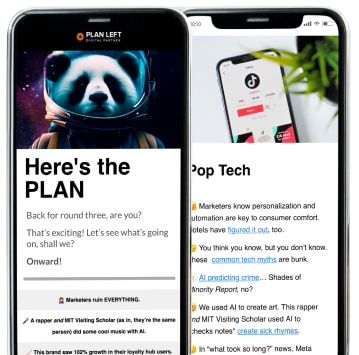
Google’s intriguing experiments with longer search snippets to keyword vs. domain branding and much more in this week’s SEO Chat. What you think you know, you may not know… yeah, we said what we said. Stay current and stay in the game with this week’s Coffee & SEO Chat.
AI Images vs Stock Photos
John Mueller of Google recently sparked a thought-provoking discussion on AI-generated images versus stock photography. His insights spoke to the impact of these choices on user experience and SEO, offering valuable guidance for website owners and SEO professionals.
Mueller distinguishes the need for authentic photographs in product showcases from the more flexible use of imagery in general content. Authentic photos are crucial for products, providing a real glimpse to consumers. For general content, however, both stock and AI-generated images can enhance aesthetic appeal without significant differences in user impact.

Mueller emphasizes the importance of quality in images, cautioning against using AI-generated images as a quick fix. He suggests that quality in professional settings often requires time and expertise and explores the potential of augmented reality for a more immersive online experience.
Mueller’s insights highlight the importance of balancing technological advancements with authenticity in visual content. The choice between AI-generated and stock images should consider user trust and engagement, making sure the visual strategy aligns with the website’s goals and audience expectations.
Keyword Domain Names vs. Branding
John Mueller, Google’s Search Advocate, recently weighed in on the value of keyword domain names versus the power of branding. In a Reddit discussion, Mueller addressed whether domains like “swimsuits.com” offer any SEO advantage due to their keyword-centric nature.
Mueller’s response was straightforward, stating that keyword domain names don’t provide a significant SEO advantage on Google. This insight is particularly relevant for those planning long-term SEO strategies. While there might be some short-term value in keyword-based domain names, Mueller suggests that this approach may not be beneficial in the long run.
One of the main drawbacks of keyword-centric domain names is their potential to limit brand recognition and versatility. Such domains can be restrictive when targeting other keywords or diversifying product or service offerings.
Mueller’s advice underscores the importance of building a strong, recognizable brand across various channels. In today’s omnichannel marketing arena, having a versatile and well-known brand is crucial for connecting with customers on search platforms and beyond.
Marketers and SEO professionals should shift their focus from relying solely on keywords to developing a comprehensive, brand-focused online presence. This strategy aligns with current SEO trends, where brand recognition and quality content are key to achieving SEO success.
Shop by Price & Shop by Brand Features in Search Results
Google’s latest update is revolutionizing the way we shop online, transforming search queries into a personalized shopping experience. The introduction of “shop by price” and “shop by brand” features in Google Search is a game-changer, simplifying the hunt for the perfect product. Whether you’re budget-conscious or brand-loyal, these features streamline your shopping journey, making it more efficient and enjoyable.
Picture this: you’re searching for a new pair of sneakers. Instead of wading through a sea of options, Google’s “shop by price” feature narrows down choices to fit your budget. For those who have a favorite brand, the “shop by brand” option neatly arranges selections in a user-friendly carousel. It’s like having a virtual shopping assistant tailored to your preferences.
For retailers and marketers, these features are a golden opportunity. They not only enhance product visibility but also align products with the interests of potential buyers. It’s a strategic way to connect the right product with the right customer at the perfect moment. This development highlights the importance of visual content in online shopping, as discussed in Plan Left’s blog “Strategic Power of Images – Boosting SEO & ADA Accessibility.” By optimizing images for SEO and ADA accessibility, businesses fully use Google’s new features to highlight their products and effectively seize a wider audience.
Google Testing Longer Search Result Snippets
Google’s latest experiment with longer search result snippets is an intriguing test, first noticed in Google Ads and now making its way to organic listings. These expanded snippets offer users more insight right on the search results page.
Imagine getting a fuller picture of a webpage’s content before even clicking through. This could mean a significant shift in how users interact with search results, potentially affecting click-through rates and overall engagement.
Google’s no stranger to playing with snippet lengths. It’s like a balancing act – finding the sweet spot between too little and too much information. These tests are part of Google’s continuous mission to refine the user search experience, always aiming to provide just the right amount of insight.
For those thinking SEO and content creation strategy, longer snippets mean more real estate to captivate potential visitors. If you weren’t already, it is time to focus efforts on crafting meta descriptions that are not just informative but also engaging, making every word count in that precious search result space.
Watercooler Highlights
We can’t end without highlighting these last but not least insights. Confusion around indexing and a callout for technical SEO awareness, plus spoiler alert—there is no ‘perfect SEO,’ but don’t take our word for it. Read what Google says below.
Achieving ‘Perfect’ SEO
“Sorry to disappoint, but your SEO is not perfect. In fact, no SEO is perfect.” This straightforward admission from John Mueller of Google might initially come off as disheartening, but it’s a vital truth in the constantly shifting world of SEO. The landscape of search engine algorithms, best practices, and user behaviors is in constant flux, making the notion of ‘perfect’ SEO more of a journey than a destination.
The real question to focus on isn’t about achieving perfection in SEO but aligning your strategies with the evolving needs of your users. Are you providing content that genuinely addresses their queries and interests? Is your website designed to offer a seamless and engaging user experience? Are you keeping pace with the latest changes in search algorithms? When your SEO efforts are centered around these aspects, you’re creating a dynamic, user-focused online presence. That’s where the true essence of effective SEO lies.
Subdomains and SEO – Indexing Perceptions
John Mueller addressed the impact of subdomains on website indexing. A user raised a concern about their site not being indexed, suspecting issues with their web application framework or HTTPS configuration. However, Mueller discovered that the site was indexed without the ‘www’ subdomain. This means that searching explicitly for the ‘www’ version yielded few results, while searching for the domain alone showed proper indexing.
This distinction is crucial because the ‘www’ version of a website is technically a subdomain of the non-www version. This technicality can lead to the perception that a site isn’t indexed when, in fact, it’s just the ‘www’ subdomain that’s not appearing in search results. Mueller’s response highlights the importance of looking beyond apparent issues when troubleshooting SEO problems. In this case, the problem wasn’t with the site’s framework or HTTPS setup but with the understanding of how different versions of a domain (with and without ‘www’) are treated by search engines.
This serves as a reminder of the complexities of SEO and the need for a thorough understanding of how different elements, like subdomains, impact a site’s visibility in search engines. It highlights the need to consider all aspects of a website’s structure when diagnosing and addressing SEO issues.
Looking to harness the latest SEO techniques and developments for your brand’s advantage but not sure where to start? Look no further—Plan Left is here to guide you through the ever-changing online landscape of SEO.
Plan Left creates solutions that endure the test of time. Our approach goes beyond the present, making sure that your website and content are relevant today and tomorrow. Ready to partner with a team that understands the depth of SEO and drives real, lasting results? Reach out to Plan Left, and let’s collaborate, elevating your brand in a way that sustains growth and success.
Explore Latest Posts
Why Competing on Price Is Killing Your Margins (And What to Do Instead) When a prospect asks "how much do ... read more
December 25, 2025
The Hidden Cost of Marketing Agencies: Why Building In-House Capabilities Matters Marketing agencies solve an immediate problem: you need marketing ... read more
December 23, 2025
How to Know Exactly Which Marketing Activities Drive Results You're investing in marketing. Social media posts go out regularly. Email ... read more
December 18, 2025
Essential Strategies for Entrepreneurs
Get Actionable Business Insights & Marketing Tips
Our newsletter delivers real-world strategies from entrepreneurs who’ve been exactly where you are.
Sign up now for:
- Actionable growth strategies that work
- Insider tactics for attracting top talent
- Real-world case studies from successful founders
- Emerging tech trends that drive innovation
- Pragmatic marketing approaches for visionary leaders




